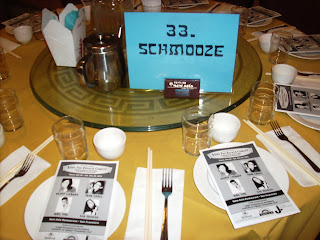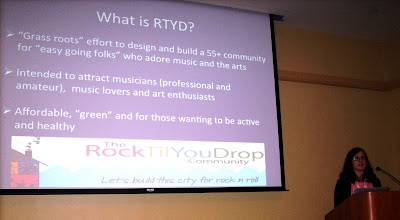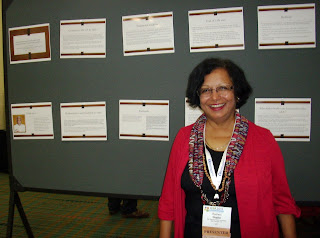"We're born alone, we
live alone, we die alone. Only through love and friendship can we create
the illusion for the moment that we're not alone." – Orson Welles
At birth, we’re alone in the sense of
separation from our mother’s womb and if we don’t have a conjoined twin.
Living with three generations under one roof
while growing up, I didn’t live alone except inside my head; in fact, the only
time I had privacy was when I was using the bathroom. When I went off to college, I was thrilled to
be alone in a room of my own (single occupancy) as I fancied myself a writer.
“…a woman must have money and a room of her own if she
is to write …”
– Virginia Woolf, A Room of One’s Own (1929)
At SOMArts
Cultural Center
I missed the exhibit’s opening night last month
when I was at GSA meeting, missed its closing celebration due to working late,
but then I had the pleasure of being alone in the gallery space on its last
night!
Marlene Iyemura’s
Circle of Togetherness: “not a physical space. Instead, it is a transcendental state that
encourages self-awareness, critical thought and heartfelt processing … an
endless series of enso paintings brought about through meditation… one that
fulfills all my needs,…spiritual, physical, or emotional.”
Natalie Sacramento’s Three Mirrors of Self-Awakening:
“I’d awaken from restful sleep to a place where I accept myself, take
action, and heal. Self-Acceptance mirror
pours gold energy on the present. Self-Prescribed
mirror reflects my aspirations and potential.
Self-Healing mirror is where I see my resiliency.”
Hediana Utarti’s Tree of Life: “place where
humanity is cherished and peace is possible … banyan tree…refuge…”
Maggie Yee's Studio Euphoria: “place where I can be alone and where creativity does not compete with everyday responsibilities."
Workstation #1: Beliefs Which Hold Me Back, Which
Carry Me Forward! Curator Cynthia Tom said about Peeling the Layers: "In order to understand and embrace what is important in your life, you must first figure out what is holding you back and what isn't working."
Reiko Fujii’s Curating
Joy: “where I feel at home with myself, surrounded by the inspirational
activities and connections with others that contribute to cultivating
happiness, confidence, and inner strength.”
Nancy Arvold’s Knitting
Together Community: “landscape with people playing and working together…
Creating community requires patience, work, and intertwining individual threads
together to make a resilient, beautiful whole.”
Susan Almazol’s Saying Yes: “where I say yes to the
Predictable markers of old age and to the Possible transformation still within
reach … transformed walkers playfully depict what’s Possible within the
Predictable.”
Irene Wibawa’s The
Cave: “represents essential elements of what I want … structure offers me
privacy and protection, reminding me that I am safe to be myself without fear of
judgment … wool lining offers me comfort while also reminding me to be soft and
kind to myself ….entrance…reminds me that this Place is unapologetic and
purposely mine.”
Workstation #3 Aspirations
that Carry Me Forward: Declare What You Want!
“Elder orphans”
Much has been written about the “problem of elder orphans” among the baby boom generation, who were one of the first to elect not to have children and now find themselves alone with no one
to help care for them when they need it:
- About one-third of Americans 45 to 63 years of age are
single, a 50% increase since 1980,
and in a position to become orphans as they age
- 1 in 5 single baby boomers is living in poverty
- Nearly one-quarter of Americans 65 and older, childless and
single, could become "elder orphans" with no family social
network of friends to provide care to them.
- In the absence of informal caregiving support, there are
not enough nursing homes and facilities to care for the growing number of
seniors who are on their own.
Can this “problem of elder orphans”
be averted by having children as potential sources of unpaid caregivers? In “The Future of Elder Orphans,” researchers Amy Ziettlow and Naomi Cahn found that few parents, who were cared for by their
children, do in fact die alone.
Maria
Torroella Carney, MD, chief of geriatric and palliative medicine at North
Shore-LIJ Health System in New York, suggested that elder orphans are a “vulnerable
population that’s likely to increase, and we need to determine what community,
social services, emergency response and educational resources can help them.” Indeed, one solution is
creating age-friendly communities with options like virtual villages, shared housing, and cohabitation.
Aging alone:
Gender vulnerability
More
people are aging alone because of demographic (longevity revolution), financial
(social security) and personal (quirkyalone is still alone,
more older couples divorcing mostly initiated by women)
reasons.
Eric Klinenberg’s Going Solo:The Extraordinary Rise and Surprising Appeal of Living Alone (2012) has a chapter, “Aging Alone,”
providing the following statistics:
- In 1950, only 1 in 10 Americans over age 65 lived
alone; today, about 1 in 3 do.
- A century ago, nearly 70% of elderly American
widows lived with a child; today, only 20% do.
- Majority of single elderly prefer living alone
over moving in with children or a nursing home.
- Only 2% of elderly widows and 20% of elderly
widowers remarry. Women who live
alone are less likely to experience mental health problems and diminished
vitality than their married peers.
- According to American Time Use Survey, between
2003 and 2006, the typical single elderly spent an average of 10 hours a
day alone.
Klinenberg notes that in
our "cult of the individual," baby boomers have made their ability to live alone
as a way to maintain independence, which they associate with dignity. Living alone does not necessarily lead to
loneliness and isolation; in fact, most solo dwellers are engaged in social and
civic life.
According to Klinenberg, aging
alone is not a social problem except in the event of a disaster. In his study of the 1995 Chicago
No one dies alone
Earlier this month I
attended the premiere of The Letters:The Untold Story of Mother Teresa,
which recounted her missionary work including founding a hospice for the poor in
the abandoned Hindu temple to goddess Kali in Kalighat Kolkata. Mother Teresa said, “No
one should die alone. Each human should
die with the sight of a loving face.”
Panel of Sages and
Spiritual Care Partners discussed Kol
Haneshema: Lessons Learned from Jewish Hospice Care at last month’s
Embracing the Journey at Jewish Community Center of San Francisco. Kol Haneshema program,
based on the belief that no one should die alone,
matches trained volunteers with an older person. One sage from the Jewish Home shared the saying of late Rabbi Alvin Fine of Temple Emanu-El: “Birth is a beginning and death a
destination; But life is a journey.”
Not alone
Had a very merry time at Kung Pao Kosher Comedy—my 1st time attending
because I wanted to support Legal Assistance to the Elderly, which was highly deserving beneficiary this year! 2 shows daily
over 3 nights, with over 2,000 attending December 24 to 26.
Kung pao (part of 7-course dinner) & veggie dim sum (cocktail)
Comedy
producer Lisa Geduldig also produced the award-winning documentary, Esther & Me (2010) about her friendship with Esther Weintraub, an octogenarian resident at the
Jewish Home in San Francisco, and founded the Jewish Home's Esther Weintraub Comedy Clinic
Comedian
Wendy Liebman said she thought she would be an old maid at age 42, but then married so with husband
and two stepsons, she is now the maid! Show
also included comedians Mike Fine and Dana Eagle.
Guests
received fortune cookies, with Yiddish messages like “A goat may have a beard, but that
doesn’t make it a rabbi” and “Guests, like fish, begin to smell after a few
days.”

















































































